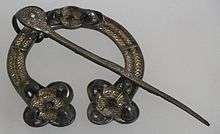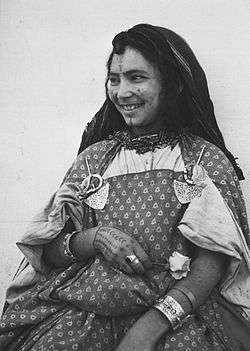Celtic brooch
The Celtic brooch, more properly called the penannular brooch, and its closely related type, the pseudo-penannular brooch, are types of brooch clothes fasteners, often rather large; penannular means formed as an incomplete ring. They are especially associated with the beginning of the Early Medieval period in the British Isles, although they are found in other times and places—for example, forming part of traditional female dress in areas in modern North Africa.

.jpg)
Beginning as utilitarian fasteners in the Iron Age and Roman period, they are especially associated with the highly ornate brooches produced in precious metal for the elites of Ireland and Scotland from about 700 to 900, which are popularly known as Celtic brooches or similar terms. They are the most significant objects in high-quality secular metalwork from Early Medieval Celtic art, or Insular art, as art historians prefer to call it. The type continued in simpler forms such as the thistle brooch into the 11th century, during what is often known as the Viking Age in Ireland and Scotland.
Both penannular and pseudo-penannular brooches feature a long pin attached by its head to a ring; the pin can move freely around the ring as far as the terminals, which are close together. In the true penannular type, the ring is not closed; there is a gap between the terminals wide enough for the pin to pass through. In the pseudo-penannular type, the ring is closed, but there are still two separately defined terminals, which are joined by a further element. The penannular type is a simple and efficient way of fastening loosely woven cloth (where the pin will not leave a permanent hole), but the pseudo-penannular type is notably less efficient.
The brooches were worn by both men and women, usually singly at the shoulder by men and on the breast by women, and with the pin pointing up; an Irish law code says that in the event of injury from a pin to another person, the wearer is not at fault if the pin did not project too far and the brooch was worn in these ways by the sexes.[1] The most elaborate examples were clearly significant expressions of status at the top of society, which were also worn by clergy, at least in Ireland,[2] though probably to fasten copes and other vestments rather than as everyday wear.[3] The Senchas Mór, an early Irish law tract, specified that the sons of major kings, when being fostered, should have "brooches of gold having crystal inserted in them", while the sons of minor kings need wear only silver brooches.[4]
Terminology
"Annular" means formed as a ring and "penannular" formed as an incomplete ring; both terms have a range of uses. "Pseudo-penannular" is a coinage restricted to brooches, and refers to those brooches where there is no opening in the ring, but the design retains features of a penannular brooch—for example, emphasizing two terminals. Some pseudo-penannular brooches are very similar in design to other penannular brooches, but have a small section joining the two terminals.[5] Others have fully joined terminals, and emphasize in their design the central area where the gap would be—for example the Tara Brooch. Pseudo-penannular brooches may also be described as "annular", or as "ring brooches".[6]
The terms "open brooch" or "open ring brooch" are also sometimes used for penannular brooches.[8] There is a scheme of classification originally set out, in relation to earlier types, by Elizabeth Fowler in the 1960s, which has since been extended in various versions to cover later types.[9]
Brooches of either penannular or annular type, where the pin is very large in relation to the ring, so that the ring cannot play any part in the fastening of the brooch, may be called "ring brooches", "pin brooches", or "brooch-pins"; or, especially where the ring is small and plain, "ringed pins".[10] In these, the design of the pin head typically shows that the pin is intended to sit underneath the ring (seen from the front), rather than on top of it as in the larger brooches.[11]
"Celtic" is a term avoided by specialists in describing objects, and especially artistic styles, of the Early Middle Ages from the British Isles, but is firmly fixed in the popular mind. The term Insular art is used to describe the distinct style of art originating in the British Isles and combining Germanic, Celtic, Pictish and Mediterranean elements. Although some simpler and relatively early penannular brooches are found in Anglo-Saxon contexts, and some sub-types predominantly so,[12] as far as is known the Anglo-Saxons did not use these brooch styles for prestige elite jewellery. However, there are elements in the style of Irish and Scottish brooches deriving from Anglo-Saxon art, and related to Insular work in other media, especially illuminated manuscripts.
Fibula is Latin for "brooch" and is used in modern languages to describe the many types of Roman and post-Roman Early Medieval brooches with pins and catches behind the main face of the brooch. The brooches discussed here are sometimes also called fibulae, but rarely by English-speaking specialists.
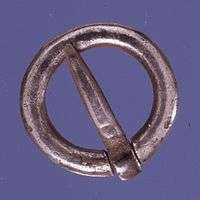 Plain silver medieval annular brooch; note that the pin cannot move along the ring
Plain silver medieval annular brooch; note that the pin cannot move along the ring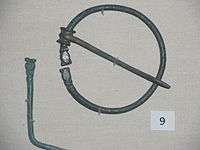 Romano-British penannular brooch in bronze
Romano-British penannular brooch in bronze Simple pseudo-penannular brooch (pin missing)
Simple pseudo-penannular brooch (pin missing) Pin-brooches and ring-pins
Pin-brooches and ring-pins
Fastening the brooches
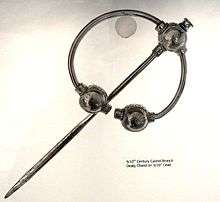
With a penannular brooch, the pin is pushed through folds of the cloth, which are then pulled back inside the ring; the free end of the pin passes through the gap in the ring. The pin is then rotated around the ring by 90 degrees or so, so that as long as the pin is held down by slight pressure it cannot escape over the terminals, and the fastening is secure.[14]
With pseudo-penannular brooches, things are not so simple and the manner in which they were used is still debated; the method was probably not the same for all brooches. One method may have been to pull folds of the cloth through the ring until they could be pierced by the pin, and then pull the cloth back until the pin rested on the ring. This would work best with brooches with a pin not much longer than the diameter of the ring, which some have, but others do not. The second method might have been simply to pin the cloth vertically, leaving the ring hanging unattached to the cloth; this does not seem very secure. The third method relied on a length of chain or cord attached to the ring near the "terminals" (which in pseudo-penannular brooches do not actually terminate), which was used to secure the pin by tying it down, perhaps with a small pin at the end, which was also put through the cloth. The Tara Brooch was probably fastened in this way.[15] In some cases the pin was fitted with a bolt or rivet to make it removable.[16] A further complication is that in some pseudo-penannular brooches the pin is fixed to lie in front of the ring, as in the Londesborough Brooch (below), but in others it crosses through the ring, starting with the head end in front of the ring, but the middle of the pin behind the ring by the point where it crosses at the other side; the Tara Brooch has been displayed set up in both ways.[17] The latter arrangement seems more common in later brooches, of the 9th century.[18]
It is fair to say that scholars remain slightly puzzled that the effective and simple penannular brooch developed in this direction,[19] though it is presumed that the reuniting of the terminals of pseudo-penannular brooches was partly to strengthen the brooch. In many penannular brooches, the gap between the terminals is now too narrow for the pin to pass through; whether this was always the case is uncertain.
History
Roman and early Insular period
Small and simple penannular brooches in bronze, iron, and, rarely, silver were common in the Roman period as a practical fastener, but were not used for high-status objects, and any decoration was normally limited to bands around the ring or other simple patterns.[20] Often the extra thickness at the terminal, necessary to prevent the pin just falling off, is achieved simply by turning back the ends of the ring.[21] In the late Roman period in Britain in the 3rd and 4th centuries, a type of penannular brooch with zoomorphic decoration to the terminals appeared, with human or animal heads, still not much wider than the rest of the ring. Some examples had enamel decoration, and the pin did not extend much beyond the ring.[22] These are found especially in southwestern Britain and Wales, and seem to have developed in these areas. This type fell from favour in southern Britain by the 5th century,[23] but was developed in Ireland by the 6–7th centuries. These types considerably extended the size of the terminals, which now presented a flattish area often decorated with enamel or glass inlay, mostly using abstracted patterns but sometimes zoomorphic decoration. The length of the pin is now often about twice the diameter of the ring.[24] The Irish cultural zone in this period included much of Western Scotland, and in Pictish East Scotland a similar development took place, though the forms are somewhat different here. The decoration paralleled that on other metalwork fittings such as pieces of harness-tackle,[25] and the few remaining early Christian reliquaries and other pieces of church metalwork.
Golden Age
.jpg)
By shortly after 700, highly elaborate, large brooches in precious metal and gems were being produced. These were clearly expressions of high status for the wearer, and use the full repertoire of goldsmith's techniques at a very high level of skill. They continued to be produced for about 200 years; the Pictish brooches are much more homogeneous in design than the Irish ones, which may indicate a shorter period of production, possibly from "the mid-eighth to the beginning of the ninth centuries".[26] Each surviving design is unique, but the range of types established in the more modest earlier brooches are developed and elaborated upon. There was no previous tradition of very ornate brooches in Ireland, and this development may have come from contact with Continental elites who wore large fibulae as marks of status. Such contacts were certainly made, especially by travelling monks.[27]
Archaeological, and some literary, evidence suggests that brooches in precious metal were a mark of royal status, along with wearing a purple cloak, and it is probably as such that they are worn by Christ on a high cross at Monasterboice and by the Virgin Mary on another.[28] All surviving examples, numbering over 50 (not all complete) in the case of the Irish ones,[29] have been recovered by excavation, or at least finding in the ground, but where the detailed circumstances of the find are known, few are from graves, and finds in hoards are much more common. When they were in graves, the burials are often much later than the date of the brooch,[30] as in a brooch in the Irish 8th century style found in a Norse burial in Westray, Orkney,[31] and possibly the Kilmainham Brooch.[32] Elaborate brooches often have one or more names—presumed to be those of owners—scratched on the reverse, often in runes. Plainer brooches in bronze and similar alloys continue to be found in much larger numbers.
The most elaborate Irish brooches are pseudo-penannular, while the Scottish ones mostly retain true penannular forms.[33] Most are silver-gilt, the gilding often partial. Some are gilded base metal, of bronze or copper-alloy;[34] only one solid gold Irish brooch is known, a 9th-century one from Loughan, County Londonderry, which is less elaborate than most of the series, though the standard of work is very high.[35] However, some brooches have a hidden recess which may have contained small lead weights to make the precious metal used seem more valuable than it actually was.[36]
In Ireland, the head of the pin might be turned into a focus for decoration, sometimes using a "kite"-shaped plate, such as that on the Tara Brooch; in Scotland, the pin-heads were simple circles formed by bending the pin back on itself.[37] Scottish terminals are more often distinct lobed or square shapes extending beyond the circle of the ring on both sides, while in Irish examples, the terminals typically extend inside the ring forming another curve, but not much outside it, or sometimes form a straight line across the interior of the ring. Irish brooches may only join the two terminals by narrow strips, or not only eliminate the gap entirely, but have a central zone of decoration where the gap between the terminals would have been; the brooches found with the Ardagh Chalice show both types.[38]

The main body was normally cast, and a number of elements of two-piece moulds have been found.[39] Many brooches have cells for studs or bosses that are most often round hemispheres, but may be square, lozenges or other shapes; very often the studs themselves are now missing. These are in a variety of materials including glass, enamel, amber, and gemstones found locally, although not including any of the classic modern "precious stones", or even the garnets found in Anglo-Saxon jewellery. However the millefiori glass rods sometimes used appear to have been imported from Italy, like those used in the Anglo-Saxon jewellery from Sutton Hoo; examples of the rods have been excavated in both Ireland and England.[40]
Like the Insular chalices and other metalwork, the very ornate Irish brooches were mostly made in many pieces which are pinned or slotted together. Filigree decoration was often made on "trays" which fitted into the main ring — on the Tara Brooch many of these are now missing (most were still in place when it was found in 1850).
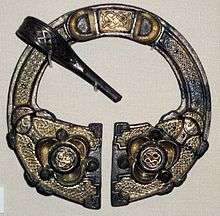
Techniques include chip-carving, cast "imitation chip-carving", filigree, engraving, inlays of various types including niello, glass and champlevé enamel, and various hammering and chasing techniques: "the range of materials and techniques is almost the full range known to man."[42] Two techniques that do not appear are the "true pierced openwork interasile, much used in Byzantine jewellery",[43] and the cloisonné work that typified much Western European jewellery, and especially large fibulae, at the time, whether in enamel or stone inlays like the garnets used so effectively at Sutton Hoo and in the Anglo-Saxon Staffordshire Hoard. In the gilded brooches, enamel is restricted to studs that punctuate the composition like gems; the larger areas of champlevé found on the flared terminals of earlier types perhaps continue in simpler types, though dating is difficult.
On some brooches the decoration is too detailed to be appreciated when the brooch is being worn, and some of the most elaborate brooches have their backs, invisible when worn, decorated almost as elaborately as their fronts. The Tara Brooch shows both features, and in addition, shares with some others a difference in decorative styles between front and back, with "Celtic" triskeles and other spiral motifs restricted to the back, while the front has more interlace and zoomorphic elements.[44] These features are also shared by the most ornate brooches in London and Edinburgh, respectively the Londesborough and Hunterston Brooches.[45] This may be because decoration on the backs relies more on engraving than filigree, which would risk wires getting caught in the clothing on which the brooch was worn.[46]
Few of the major brooches, or indeed other metalwork, have been found in contexts that can be easily dated, and much of the dating of at least the earlier ones comes from comparison with Insular illuminated manuscripts, though the dating of these is often itself far from certain. The Tara Brooch has long been recognised as having clear stylistic similarities to the Lindisfarne Gospels, thought to date to about 698–715. Many of the similarities are to the carpet pages, highly detailed ornamental pages filled with decoration, which share with the brooch a certain horror vacui that leaves no area unembellished, and also complex decoration that is extremely small and perfectly executed, and best appreciated when seen at a larger than actual scale, whether in the original or in photographs. Both combine elements from many stylistic origins into a style that is distinctly Insular: La Tène Celtic art, Germanic animal style, and classical and other Mediterranean styles.
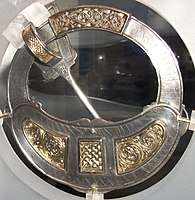 Rear of the Hunterston Brooch, an early and elaborate Irish-style brooch found in Scotland, showing a much later Viking owner's inscription
Rear of the Hunterston Brooch, an early and elaborate Irish-style brooch found in Scotland, showing a much later Viking owner's inscription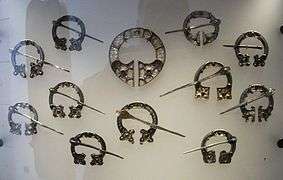 The Pictish brooches in the St Ninian's Isle Treasure, with typical Pictish lobed terminals
The Pictish brooches in the St Ninian's Isle Treasure, with typical Pictish lobed terminals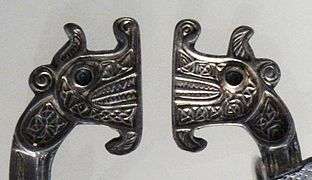 Pictish confronted animal terminals, St Ninian's Isle Treasure
Pictish confronted animal terminals, St Ninian's Isle Treasure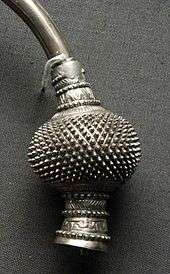 "Brambled" terminal on a thistle brooch
"Brambled" terminal on a thistle brooch
Later brooches, and the Vikings

The Vikings began to raid Ireland from 795, with catastrophic effect for the monasteries in particular. However, although the Vikings established several longphorts, initially fortified encampments for over-wintering, and later towns like Dublin, Wexford, Cork, and Waterford (the first real urban centres in Ireland), the native Irish were more successful than the English and Scots in preventing large-scale Viking takeovers of areas for settlement by farmers. By about the year 1000, the situation was relatively stable, with a mixed population of Norse-Gaels in the towns and areas close to them, while the Gaelic Irish, whose elite had often formed political alliances, trading partnerships and inter-marriages with Viking leaders, remained in control of the great majority of the island, and were able to draw tribute from the Viking towns.[47]
The period is characterised by a greatly increased availability of silver, presumably the result of Viking raiding and trading, and most brooches are made from silver throughout, as gilding and decoration in other materials nearly disappears. The brooches are often large and relatively massive, but plainer than the most elaborate earlier ones, neither using older local decorative styles nor the Viking styles that were adopted in other media. This continues a trend that can be detected in later brooches from the preceding period, before much Viking influence can have made itself felt. The 9th century Roscrea Brooch is one of a number of transitional brooches; though its form is highly ornate, with a large flat triangular pin head, the ring is thick plain silver, the gold filigree panels occupy relatively small areas, and their workmanship is a "coarse" or "crude" imitation of that of earlier works.[48] The Kilamery Brooch is a comparable example, with a marked emphasis on plain flat silver surfaces.[49] There are rare exceptions in which a highly decorated brooch shows Scandinavian stylistic and technical influence, notably an Irish brooch from Rathlin Island, with areas stamped where the Irish tradition would have used casting.[50]
The brooches appear to have been made by "native" metalworkers, but worn by both Vikings and Gaels.[51] The very popular thistle brooches have terminals and often pin-heads that are like thistle flowers, with a ball topped by a round projection, often flared; they are called by the term regardless of whether or not the ball is "brambled"—that is, formed with a regular pattern of small tapering projections, like the two lowest brooches from the Penrith Hoard illustrated here. These, and other globular endings to terminals and pin-heads, were common, but flattened terminals continued to be made, now ornamented by round silver bosses amid simple repeated patterns, or interlace that is larger in scale than in the earlier ornate badges. In these, the ring often ends in a "gripping beast" biting the terminal plate. The mixture of types seen in the 10th century Penrith Hoard is typical.[52]
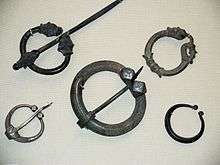
Insular brooches had been taken back to Scandinavia, and began to be produced there in the 10th century for wearing singly by men at the shoulder; Viking women wore pairs of characteristic oval brooches on the upper breast.[53] Most were simpler than Insular examples, and several hundred examples in "tinned bronze rather than silver" are known.[54] The 10th century Danish Møllerløkken Brooch is the most elaborate example known, with a simple overall design with ball terminals and pin-head, but with rich detailing such as interlace panels on the ring and filigree sections on the balls.[55] Other Insular types were also produced in Viking areas of England, especially Scandinavian York.[56] The penannular brooch fell from common use by the end of the 11th century, a time when Ireland and Scotland, and Scandinavia, were adopting general Western European styles in many areas of both art and life.
A distinctly Irish type of brooch found at the end of the Viking period is the kite brooch, whose name derives from the almond shape called a "kite" in heraldry, though the shapes of the heads are actually highly variable. They were apparently worn, like the larger brooches, singly with the pin pointing upwards. Only "about half a dozen" exist in silver, including examples that are much larger than average, with pins up to 7.9 cm long.[57] In these, there is no ring, but the elaborate head is connected to a pin of very variable length by a short tab of metal that can move on joints at both ends; there is also usually a cord for winding round the pin to secure it. Only 14 of these brooches have been found to date in Ireland, many incomplete, and none elsewhere;[58] five of these are from Dublin, the earliest from the 940s. They appear for about a further two centuries;[59] by around 1200, typical medieval ring brooches that have little distinctively Irish about them are found instead.[60]
Celtic Revival

The brooches we have today have been discovered since the 17th century, and their odds on their survival once found have increased greatly over that period, as their value as artefacts has overtaken their scrap value. In the 19th century, as part of the Celtic Revival, many brooches copying or inspired by earlier styles were made.[61]
Much of the responsibility for the fashion for high-quality Celtic Revival jewellery belongs to George Waterhouse, a jeweller from Sheffield, England, who moved to Dublin in 1842. Before the end of the decade, he and the long-established Dublin firm West & Son of College Green (later moving to Grafton Street) were finding it necessary to register their designs to prevent copying. Of the various types of objects made, the brooches were both the "most resonant" and those which could be sold with the least alteration to the original form and design, although the jewellers generally reduced their size and fitted them with conventional pins and catches behind, even though the Kashmir shawls that were also fashionable at the time were often loosely woven and not unsuitable for fastening in the original way.[62] Different versions were made at different price levels, though even the most expensive struggled to recreate the full intricacy of the originals.
The National Museum of Ireland is clearly not correct in saying that the fashion began after Queen Victoria was presented with a replica of the "Cavan Brooch" on her visit to Dublin to see the Great Industrial Exhibition in 1853;[63] the Royal Collection has two brooches that Prince Albert bought for her from West & Son in 1849 on an earlier visit to Dublin, which were already being made in editions. Albert presented them in November and at Christmas that year: "...such beautiful souvenirs, both made after those very curious old Irish ornaments we saw in the College in Dublin, one a silver shawl brooch, in smaller size than the original" was her reaction to the November gift.[64] A later gift from Albert included a setting of a cairngorm he had picked up when walking in the Scottish Highlands, a more authentic type of gem than the brightly coloured foreign stones used in much Celtic Revival jewellery.[65]
The discovery of the Tara Brooch in 1850 could therefore not have been better timed in terms of attracting public interest. The brooch was immediately recognised as the culminating masterpiece (though early in date) of the Irish development of large and superbly worked ornate brooches, a status it has retained ever since. The brooch was soon acquired by George Waterhouse, who used it as the centre of displays of his replicas and imitations of Celtic brooches in his Dublin shop, also exhibiting it at The Great Exhibition in London in 1851 and the Paris Exposition Universelle (1855), as well as the Dublin exhibition visited by the Queen in 1853 (Victoria had already seen it; it had been specially sent to Windsor Castle for her inspection).
Waterhouse had invented the brooch's name; in fact, it has nothing to do with the Hill of Tara, but the true circumstances of its find still remain unclear (essentially to avoid a claim by the landowner), and Waterhouse chose to link it to the site associated with the High Kings of Ireland, "fully aware that this would feed the Irish middle-class fantasy of being descended from them".[66] By the time the brooch passed to what is now the National Museum of Ireland in the 1870s, "Tara brooch" had become a generic term for Celtic Revival brooches, some of which were now being made by Indian workshops for export to Europe.[67] Replicas, very rarely fully accurate, and imitations of Celtic brooches have continued to be made to the present day, at varying levels of quality.
Modern North Africa
Penannular brooches are part of traditional dress to the present day among Berber women in the Maghreb, usually worn in pairs and apparently pinning straps of a dress to the bodice, with the pins pointing straight up.[68] They are usually large, fairly plain, brooches, not unlike some Viking examples, though another style has a very elaborately decorated head to the pin, which can dwarf the ring.[69] A heavy necklace often hangs between the two brooches, sometimes attached to a ring hanging from the head of the pin. Most of the women are identified as Berber. Local names for the brooches apparently include melia, melehfa, bzima, kitfiyya, and khellala in Arabic, and tabzimt, tizerzay, and tazersit in Berber. Such styles are believed to have been in use since pre-Islamic times.[70]
Notes
- Youngs, 89, NMI, O'Floinn, 172–173
- Youngs, 72, NMI, O'Floinn, 177.
- Laing, 304
- Laing, 304
- For example, this brooch in the British Museum. Silver ring brooch
- The last favoured by NMI, O'Floinn, 177 and entries.
- Youngs, no. 111, with a plate showing the decoration much better; Laing, 310
- Essentially in material aimed at the general public, to avoid the "p" word—for example, "open brooch" in the headings of the database of the National Museums of Scotland, but not in the detailed descriptions. The British Museum display captions favour "open ring".
- Fowler's two papers are in Further Reading. Laing 304–316 summarizes one version of the expanded typology.
- Laing, 316 and 318–320, using both, but distinguishing between them. Youngs uses the second and third (no.s 90–92, 95–96), Edwards, 141 the last.
- Usually the pin is bent round to form a simple ring, and though the pin may be capable of being swivelled round to sit in front of the ring, it will then project away from the ring.
- Dickinson, 52–54
- At the British museum; this You Tube video shows the operation from about 1:20
- Whitfield (2001), 229–230, with diagrams. There is a short video sequence here. See also Johns, 150.
- Whitfield (2001), 229–230, with diagram of the Tara Brooch; see also a series of photos from the National Museums of Scotland
- Laing, 310
- The photographs here, showing the pin lying on top, were taken at the NMI in 2010; the illustrations in "NMI" of 2002, and Youngs of 1989, show it crossing through the ring.
- For example the Roscrea, Ardagh, and Killamery Brooches - respectively Youngs, nos. 79, 76 & 80, and also in NMI. Which brooches have removable pins, so that the arrangement can be altered, is not always clear from the sources.
- See, for example, Youngs, 89.
- Johns, 150–151. Examples of Romano-British penannular broches from Darwin Country
- Example from the UK Detector Finds Database
- Youngs, 21, and no. 15. NMI, O'Floinn, 172–173
- NMI, O'Floinn, 173; another summary account
- Youngs, 21–22, and catalogue nos. 16–19; NMI, no. 5:5; example from the British Museum
- See Youngs, 117–120 for examples
- Youngs, 90
- Whitfield (2001), 217
- Whitfield (2001), 223-226
- NMI, O'Floinn, 177
- Laing, 304,
- Youngs, no. 195.
- Ship, Harrison, 72; Youngs, no. 74; NMI, 185
- Youngs, 89–90
- For example, Youngs nos.195 and 75
- Youngs, no. 83; NMI, 184; photo
- British Museum, mentioning two examples.
- Youngs, 90
- NMI, 245
- Youngs, 170–171, 189–193; NMI, 176–177
- Youngs, 202–204
- Youngs, 94–95
- Youngs, 171–173, quote 171
- Youngs, 171–173
- NMI, O'Floinn, 177; Youngs, 207
- Youngs, nos. 69 and 71; Hunterston Brooch from NMI; see external links for the other museum pages.
- NMI, 183
- Ship, Doherty, 34–35
- NMI, 215–216, and 230, "crude"; Youngs, no. 79, "coarse". Illustration here
- NMI, 215; photo
- Ship, O'Floinn, 90;
- NMI, Wallace, 213–216
- Compare the very similar selections of brooches illustrated at NMI 238 and 240.
- Vikings, 102
- Ship, O'Floinn, 89
- Vikings, 112–113, 146; Ship, O'Floinn, 89
- Laing, 312
- NMI, 227
- Whitfield (2005), 64–67; The Waterford Kite brooch, plus one in the next reference.
- kite brooches
- The Waterford Ring Brooch
- Victorian penannular brooches from the V&A Museum.
- Gere and Rudoe, 444.
- NMI, 5:21
- Royal Collection Archived June 9, 2011, at the Wayback Machine, Brooch given in November 1849, and Christmas 1849. Their fabrication was sub-contracted to Edward Johnston's workshop. See also the V&A text at the link above, also dating the fashion to the 1840s.
- British Museum Waterhouse replica of the Tara Brooch, with text from "catalogue of Hull Grundy Gift (Gere et al 1984) no. 989" covering other replicas and the revived brooch in general
- Gere and Rudoe, 444; British Museum: Waterhouse replica of the Tara Brooch, see note above.
- Gere and Rudoe, 455
- Johns, 151. Photos from Tunisia, and another recent one.
- Elaborate Berber brooches from Corbis.
- Victoria & Albert Museum "Penannular brooch"
References
- Dickinson, Tania M., Fowler's Type G penannular brooches reconsidered, 1982, Medieval Archaeology, PDF
- Edwards, Nancy. The Archaeology of Early Medieval Ireland, Routledge, 1996, ISBN 0-415-22000-9, ISBN 978-0-415-22000-2
- Gere, C. and Rudoe J., Jewellery in the Age of Queen Victoria: a Mirror to the World, 2010, British Museum Publications, ISBN 0-7141-2819-8
- Johns, Catherine, The Jewellery of Roman Britain: Celtic and Classical Traditions, Routledge, 1996, ISBN 1-85728-566-2, ISBN 978-1-85728-566-6, Google books
- Laing, Lloyd Robert. The archaeology of late Celtic Britain and Ireland, c. 400–1200 AD, Taylor & Francis, 1975, ISBN 0-416-82360-2, ISBN 978-0-416-82360-8, google books
- Youngs, Susan (ed), "The Work of Angels", Masterpieces of Celtic Metalwork, 6th–9th centuries AD, 1989, British Museum Press, London, ISBN 0-7141-0554-6
- "NMI": Wallace, Patrick F., O'Floinn, Raghnall eds. Treasures of the National Museum of Ireland: Irish Antiquities, 2002, Gill & Macmillan, Dublin, ISBN 0-7171-2829-6
- "Ship": Larsen, Anne Christine (ed), The Vikings in Ireland, 2001, The Viking Ship Museum, Roskilde, ISBN 87-85180-42-4, online text
- Whitfield, Niamh (2001), The "Tara" Brooch, in Hourihane, Colum (ed), From Ireland coming: Irish art from the early Christian to the late Gothic period and its European context, Princeton University Press, 2001, ISBN 0-691-08825-X, 9780691088259
- Whitfield, Niamh (2005), "A brooch fragment from Dublin", in Bork, Robert Odell and Montgomery, Scott, De re metallica: the uses of metal in the Middle Ages, 2005, Ashgate Publishing, Ltd., ISBN 0-7546-5048-0, ISBN 978-0-7546-5048-5, google books
Further reading
- Fowler, Elizabeth. The origins and developments of the penannular brooch in Europe, Proceedings of Prehistorical Society, XXVI, 1960, Cambridge, 149–177 (with the next paper initiated the Fowler typology).
- Fowler, Elizabeth. Celtic Metalwork of the fifth and sixth centuries A.D.: A Reappraisal, Archaeological Journal 120 (1963), 99160
- Graham-Campbell, J., Some Viking-Age penannular brooches from Scotland and the origins of the 'thistle-brooch' in From the stone age to the 'forty-five: studies presented to R. B. K. Stevenson, former Keeper, National Museum of Antiquities of Scotland (Edinburgh, 1983), pp. 310–23
External links
| Wikimedia Commons has media related to Penannular brooches. |
- Irish Brooches of the Early Medieval Celtic Period, An exhibition by Alisa Petti
- The Londesborough Brooch
- Hunterston Brooch National Museums of Scotland
- St Ninian's Isle Treasure, National Museums of Scotland
- Victorian web, gallery of "Victorian Jewelry: Celtic Revival Work in Ireland"
- Treasures of early Irish art, 1500 B.C. to 1500 A.D., an exhibition catalogue from The Metropolitan Museum of Art (fully available online as PDF), which contains material on Penannular brooches (cat. no. 40, 41, 42, 46-52)
